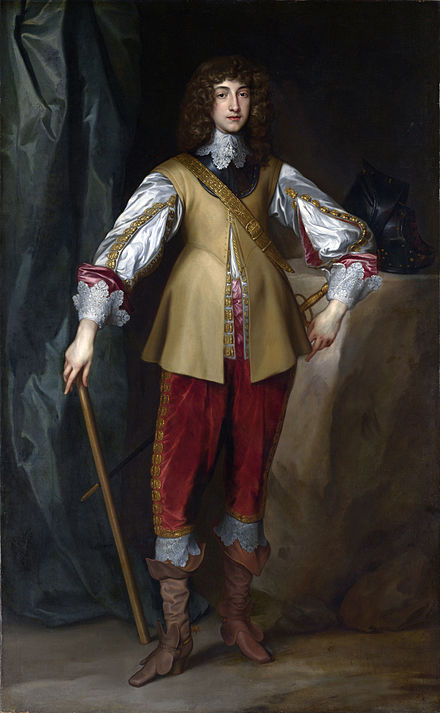Cavalier
The term "Cavalier" (/ˌkævəˈlɪər/) was first used by Roundheads as a term of abuse for the wealthier royalist supporters of King Charles I and his son Charles II of England during the English Civil War, the Interregnum, and the Restoration (1642 – c. 1679). It was later adopted by the Royalists themselves. Although it referred originally to political and social attitudes and behaviour, of which clothing was a very small part, it has subsequently become strongly identified with the fashionable clothing of the court at the time. Prince Rupert, commander of much of Charles I's cavalry, is often considered to be an archetypal Cavalier.[1]
Cavalier derives from the same Latin root as the Italian word cavaliere, the French word chevalier, and the Spanish word caballero, the Vulgar Latin word caballarius, meaning 'horseman'. Shakespeare used the word cavaleros to describe an overbearing swashbuckler or swaggering gallant in Henry IV, Part 2 (c. 1596–1599), in which Robert Shallow says "I'll drink to Master Bardolph, and to all the cavaleros about London".[2] Shallow returns in The Merry Wives of Windsor (c. 1597), where he is called "Cavaleiro Justice" (knightly judge) and "bully rook", a term meaning "blustering cheat".[3][4]
"Cavalier" is chiefly associated with the Royalist supporters of King Charles I in his struggle with Parliament in the English Civil War. It first appears as a term of reproach and contempt, applied to the followers of King Charles I in June 1642:
1642 (June 10) Propositions of Parlt. in Clarendon v. (1702) I. 504 Several sorts of malignant Men, who were about the King; some whereof, under the name of Cavaliers, without having respect to the Laws of the Land, or any fear either of God or Man, were ready to commit all manner of Outrage and Violence. 1642 Petition Lords & Com. 17 June in Rushw. Coll. III. (1721) I. 631 That your Majesty..would please to dismiss your extraordinary Guards, and the Cavaliers and others of that Quality, who seem to have little Interest or Affection to the publick Good, their Language and Behaviour speaking nothing but Division and War.[2]
Charles, in the Answer to the Petition 13 June 1642, speaks of Cavaliers as a "word by what mistake soever it seemes much in disfavour".[5] It was soon reappropriated as a title of honour by the king's party, who in return applied Roundhead to their opponents. At the Restoration, the court party preserved the name, which survived until the rise of the term Tory.[5]
Cavalier was not understood at the time as primarily a term describing a style of dress, but a whole political and social attitude. However, in modern times the word has become more particularly associated with the court fashions of the period, which included long flowing hair in ringlets, brightly coloured clothing with elaborate trimmings and lace collars and cuffs, and plumed hats.[6] This contrasted with the dress of at least the most extreme Roundhead supporters of Parliament, with their preference for shorter hair and plainer dress, although neither side conformed to the stereotypical images entirely.[7]



_1644_Triple_Unite_of_Charles_I.jpg/440px-England_(Great_Britain)_1644_Triple_Unite_of_Charles_I.jpg)